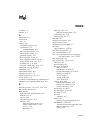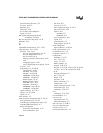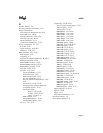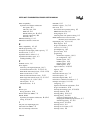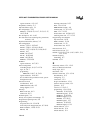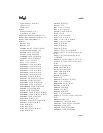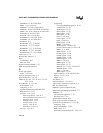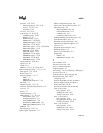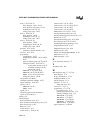
INTEL386™ EX MICROPROCESSOR USER’S MANUAL
Index-4
DOS compatibility
departures from PC/AT architecture
bus signals,
B-2
CPU-only reset, B-4
DMA unit, B-1
HOLD, HLDA pins, B-4, B-5
interrupt control unit, B-4
SIO units, B-4
DRAM, refreshing, 15-12
DRAM, See Refresh control unit
E
EISA compatibility, 4-3–4-5
ESE bit programming, 4-8
Exceptions and interrupts, relative priority, 7-7
Execution Unit, 3-4, 3-5
Expanded address, defined, 1-4
Expanded I/O address space, 4-3
enabling/disabling, 4-8
F
FaxBack service, 1-6
Flow diagram
CSU bus cycle length adjustment,
14-12
demand data-transfer mode, 12-22–12-24
DMA block data-transfer mode, 12-19–12-20
DMA cascade mode, 12-26
DMA demand data-transfer mode, 12-22
DMA single data-transfer mode, 12-15–12-17
interrupt process, 9-11, 9-12, 9-13
SIO reception, 11-11
SIO transmission, 11-8
H
HALT cycle
Ready generation,
8-10
HALT restart from SMM, 7-9
HOLD, HLDA
departures from PC/AT architecture,
B-4, B-5
timing, 6-20, 6-35
I
I/O ports, See Input/output ports
I/O restart from SMM,
7-9
ICU, See Interrupt control unit
IDCODE, 18-2
Identifier registers, 3-6, 7-15
Idle mode, 8-9
bus interface unit operation during, 8-5
SMM interaction with, 8-5
timing diagram, 8-9
watchdog timer unit operation during, 8-5
IEEE Standard Test Access Port and
Boundary-Scan Architecture,
18-1
Input/output ports, 16-1–16-10
block diagram, 16-2
design considerations, 16-10
overview, 16-1–16-5
pin multiplexing, 16-5
pin reset status, 16-5
programming
initialization sequence,
16-10
pin configuration, 16-7
PnCFG register, 16-7
PnDIR register, 16-8
PnLTC register, 16-8
PnPIN register, 16-9
register addresses, 4-19, D-5
registers, 16-6
signals, 16-5
Instruction Decode Unit, 3-4
Instruction Queue, 3-5
Instruction Register (IR), 18-7
Instructions, notational conventions, 1-3
Interrupt control unit, 9-1–9-30
configuring, 5-7
departure from PC/AT architecture, B-4
design considerations, 9-29
interrupt acknowledge cycle, 9-29–9-30
interrupt detection, 9-29
interrupt polling, 9-14–9-15
interrupt priority, 9-6–9-8
assigning an interrupt level, 9-6
changing the default interrupt structure, 9-7
determining priority, 9-7–9-8
interrupt process, 9-9–9-14
interrupt sources, 9-4
interrupt service routine, 6-23
interrupt vectors, 9-8








